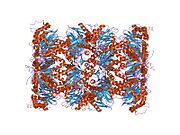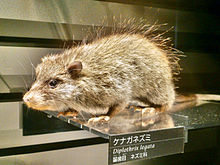PSMA4
PSMA4프로테아솜 소단위 알파-4는 마크로핀 소단위 C9, 프로테아솜 성분 C9, 20S 프로테아솜 소단위 알파-3로도 알려져 있으며, 인간에서 PSMA4 유전자에 의해 암호화된 단백질이다.[5]이 단백질은 20S 프로테아솜 콤플렉스의 완전한 조립에 기여하는 17개의 필수 서브유닛(알파 서브유닛 1-7, 구성 베타 서브유닛 1-7, 유도성 서브유닛(베타1i, 베타2i, 베타5i 포함) 중 하나이다.
구조
단백질 표현
PSMA4 유전자는 20S 코어 알파 서브 유닛인 펩티다아제 T1A 계열의 멤버를 인코딩한다.[6]이 유전자는 9개의 exon을 가지고 있으며 15q25.1 염색체 밴드에 위치한다.인간 단백질 프로테아솜 서브유닛 알파-4는 크기가 29.5kDa이고 261개의 아미노산으로 구성되어 있다.이 단백질의 계산된 이론적 pI는 6.97이다.[7]
복합 조립체
프로테아솜은 20S 코어 구조의 다발성 단백질 분해효소 복합체다.이 배럴 모양의 중심 구조는 28개의 비식별 서브유닛의 축방향으로 쌓은 4개의 링으로 구성되어 있는데, 두 개의 엔드 링은 각각 7개의 알파 서브유닛으로 형성되어 있고, 두 개의 중앙 링은 각각 7개의 베타 서브유닛으로 형성되어 있다.3개의 베타 서브유닛(베타1, 베타2, 베타5)은 각각 단백질 활성 사이트를 포함하고 있으며 기질 선호도가 뚜렷하다.프로테아솜은 높은 농도의 진핵 세포와 클레이브 펩타이드가 비 리소솜 경로에서 ATP/ubiquitin 의존적 공정으로 분산된다.[8][9]
함수
격리된 20S 프로테아솜 콤플렉스의 결정 구조는 베타 서브유닛의 두 링이 프로테롤리틱 챔버를 형성하고 챔버 내에서 프로테롤리시스의 모든 활성 부위를 유지한다는 것을 보여준다.[9]이와 동시에 알파 서브유닛의 고리는 단백질의 방으로 들어가는 기판을 위한 입구를 형성한다.비활성화된 20S 프로테아솜 콤플렉스에서 내부 프로테아실로의 게이트는 특정 알파 서브 유닛의 N단자 꼬리로 보호된다.[10][11]20S 코어 입자(CP)의 단백질 용량은 CP가 알파 링의 한쪽 또는 양쪽 모두에서 하나 또는 두 개의 규제 입자(RP)와 연결될 때 활성화될 수 있다.이러한 규제 입자에는 19S 프로테아솜 콤플렉스, 11S 프로테아솜 콤플렉스 등이 포함된다.CP-RP 협회에 따라 특정 알파 서브유닛의 확인이 변경되어 결과적으로 기판 출입문이 열리는 원인이 된다.RPs 외에도, 20S 프로테아솜은 낮은 수준의 도데실황산나트륨(SDS) 또는 NP-14에 노출되는 것과 같은 다른 가벼운 화학적 치료에도 의해 효과적으로 활성화될 수 있다.[11][12]
진핵 단백질은 분해성 단백질을 인식했는데, 여기에는 단백질 품질 관리 목적을 위한 손상된 단백질이나 동적 생물학적 과정을 위한 주요 규제 단백질 성분이 포함된다.변형된 프로테아솜의 필수적인 기능인 면역단백제는 클래스 I MHC 펩타이드의 처리다.알파 링의 구성 요소로서 프로테아솜 서브 유닛 알파 타입-4는 헵타의 알파 링과 기질 입구 게이트의 형성에 기여한다.중요한 것은, 이 서브 유닛이 19S 베이스와 20S의 조립에 중요한 역할을 한다는 것이다.19S와 20S 사이의 결합 과정을 설명하기 위해 사카로미스 세레비시아 프로테아솜 코어 입자 20S와 규제 입자 19S(인간 프로테아솜과 유사) 베이스 성분을 사용한 연구에서, 19S 서브 유닛 Rpt6 하나가 알파2와 알파3 서브 유닛에 의해 형성된 포켓에 꼬리를 삽입할 수 있다는 증거가 나왔다(체계적인 명명법 기준).)) 20S 및 19S 기본 구성 요소 간의 복잡한 형성을 촉진한다.[13]
임상적 유의성
프로테아솜과 그 서브유닛은 적어도 두 가지 이유로 임상적으로 중요한데, (1) 손상된 복합체 결합 또는 기능장애 프로테아솜은 특정 질병의 근본적인 병태생리와 관련될 수 있으며, (2) 치료적 개입의 약물 대상으로 악용될 수 있다.보다 최근에는 새로운 진단 마커와 전략의 개발을 위한 프로테아솜을 고려하는 노력이 더 많이 이루어지고 있다.프로테아좀의 병태생리학에 대한 개선되고 포괄적인 이해는 향후 임상적 응용으로 이어져야 한다.
프로테아솜은 유비퀴틴-단백질 시스템(UPS)과 해당 세포 단백질 품질 관리(PQC)의 중추적 구성 요소를 형성한다.단백질 편재와 그에 따른 프로테아솜에 의한 단백질 분해와 분해는 세포 주기, 세포 성장과 분화, 유전자 전사, 신호 전달 및 세포 사멸의 조절에 있어 중요한 메커니즘이다.[15]그 후 단백질 복합체 조립 및 기능이 손상되면 단백질 분해 활동이 감소하고 단백질 종들이 손상되거나 잘못 접히는 현상이 발생한다.이러한 단백질이 축적되면 신경퇴행성질환,[16][17] 심혈관질환,[18][19][20] 염증반응 및 자가면역질환,[21] 전신 DNA손상반응에서 병생성과 표현특성에 기여하여 악성종양으로 이어질 수 있다.[22]
몇몇 임상 실험 연구 성격의 UPS수차와 규제 완화 등 몇몇이고myodegenerative 신경 퇴행성 질환의 발병에 기여하고의 disease,[25]근 위축성 측색 경화(근 위축성 측색 경화증)[25]헌팅턴 disease,[24]Creutz다 알츠하이머 disease,[23]파킨슨 병 disease[24]등을 표시했습니다.feldt–Jakob disease,[26]그리고 운동 뉴런 질환, 폴리글루타민(PolyQ) 질환, 근위축성[27] 및 치매와 관련된 몇 가지 희귀한 형태의 신경퇴행성 질환이 있다.[28]유비퀴틴-단백질계통(UPS)의 일부로서 프로테아솜은 심장 단백질 동점증을 유지하여 심장 허혈성 부상,[29] 심실 비대증[30], 심부전 등에 큰 역할을 한다.[31]게다가, UPS가 악성 변형에 필수적인 역할을 한다는 증거가 축적되고 있다.UPS 단백질 분해는 암의 발병에 중요한 자극 신호에 대한 암세포의 반응에 중요한 역할을 한다.따라서 p53, c-준, c-Fos, NF-bB, c-Myc, HIF-1α, MATα2, STAT3, 스테롤 조절 요소 결합 단백질 및 안드로겐 수용체와 같은 전사 인자의 저하로 인한 유전자 발현이 모두 UPS에 의해 제어되어 다양한 악성종양 개발에 관여한다.[32]Moreover, the UPS regulates the degradation of tumor suppressor gene products such as adenomatous polyposis coli (APC) in colorectal cancer, retinoblastoma (Rb). and von Hippel–Lindau tumor suppressor (VHL), as well as a number of proto-oncogenes (Raf, Myc, Myb, Rel, Src, Mos, ABL).UPS도 염증반응 규제에 관여하고 있다.이러한 활동은 대개 TNF-α, IL-β, IL-8, 접착분자(ICAM-1, VCAM-1, P-selectin)와 프로스타글란딘과 질산화물(NO)과 같은 프로테아그란딘의 발현을 더욱 조절하는 NF-164B의 활성화에 있어서 프로테아솜의 역할에 기인한다.[21]또한 UPS는 주로 사이클린의 단백질 분해와 CDK 억제제의 저하를 통해 백혈구 증식의 조절자로서 염증 반응에도 역할을 한다.[33]마지막으로, SLE, Sögren 증후군, 류마티스 관절염(RA)을 앓고 있는 자가면역질환자들은 임상 바이오마커로 응용할 수 있는 순환 프로테아솜을 주로 나타낸다.[34]
유전적 요인이 암 발생에 결정적인 역할을 하기 때문에 게놈전위 연관 연구(GWAS)는 15q25.1 염색체를 폐암의 민감성과 연관시키고 프로테아솜 소단위 알파형-4(PMSA4)를 후보 유전자로 포함시켰다.폐암 환자와 중국 한족의 대조군에 대한 환자-대조군 연구가 조사되었고 PSMA4와 폐암의 연관성을 제안했다.[35]또한, PMSA4는 또한 AS(Ankylosing Spondylitis)의 병원 발생에 관여하는 것으로 간주되어 AS에서 임상 적용을 위한 잠재적 바이오마커일 수 있다.[36]
상호작용
PSMA4는 PLK1과 상호작용하는 것으로 나타났다.[37]
참조
- ^ a b c GRCh38: 앙상블 릴리스 89: ENSG000041357 - 앙상블, 2017년 5월
- ^ a b c GRCm38: 앙상블 릴리스 89: ENSMUSG000032301 - 앙상블, 2017년 5월
- ^ "Human PubMed Reference:". National Center for Biotechnology Information, U.S. National Library of Medicine.
- ^ "Mouse PubMed Reference:". National Center for Biotechnology Information, U.S. National Library of Medicine.
- ^ Tamura T, Lee DH, Osaka F, Fujiwara T, Shin S, Chung CH, Tanaka K, Ichihara A (May 1991). "Molecular cloning and sequence analysis of cDNAs for five major subunits of human proteasomes (multi-catalytic proteinase complexes)". Biochimica et Biophysica Acta (BBA) - Gene Structure and Expression. 1089 (1): 95–102. doi:10.1016/0167-4781(91)90090-9. PMID 2025653.
- ^ "Entrez Gene: PSMA4 proteasome (prosome, macropain) subunit, alpha type, 4".
- ^ Kozlowski LP (October 2016). "IPC - Isoelectric Point Calculator". Biology Direct. 11 (1): 55. doi:10.1186/s13062-016-0159-9. PMC 5075173. PMID 27769290.
- ^ Coux O, Tanaka K, Goldberg AL (1996). "Structure and functions of the 20S and 26S proteasomes". Annual Review of Biochemistry. 65: 801–47. doi:10.1146/annurev.bi.65.070196.004101. PMID 8811196.
- ^ a b Tomko RJ, Hochstrasser M (2013). "Molecular architecture and assembly of the eukaryotic proteasome". Annual Review of Biochemistry. 82: 415–45. doi:10.1146/annurev-biochem-060410-150257. PMC 3827779. PMID 23495936.
- ^ Groll M, Ditzel L, Löwe J, Stock D, Bochtler M, Bartunik HD, Huber R (April 1997). "Structure of 20S proteasome from yeast at 2.4 A resolution". Nature. 386 (6624): 463–71. Bibcode:1997Natur.386..463G. doi:10.1038/386463a0. PMID 9087403.
- ^ a b Groll M, Bajorek M, Köhler A, Moroder L, Rubin DM, Huber R, Glickman MH, Finley D (November 2000). "A gated channel into the proteasome core particle". Nature Structural Biology. 7 (11): 1062–7. doi:10.1038/80992. PMID 11062564.
- ^ Zong C, Gomes AV, Drews O, Li X, Young GW, Berhane B, Qiao X, French SW, Bardag-Gorce F, Ping P (August 2006). "Regulation of murine cardiac 20S proteasomes: role of associating partners". Circulation Research. 99 (4): 372–80. doi:10.1161/01.RES.0000237389.40000.02. PMID 16857963.
- ^ Park S, Li X, Kim HM, Singh CR, Tian G, Hoyt MA, Lovell S, Battaile KP, Zolkiewski M, Coffino P, Roelofs J, Cheng Y, Finley D (May 2013). "Reconfiguration of the proteasome during chaperone-mediated assembly". Nature. 497 (7450): 512–6. Bibcode:2013Natur.497..512P. doi:10.1038/nature12123. PMC 3687086. PMID 23644457.
- ^ Kleiger G, Mayor T (June 2014). "Perilous journey: a tour of the ubiquitin-proteasome system". Trends in Cell Biology. 24 (6): 352–9. doi:10.1016/j.tcb.2013.12.003. PMC 4037451. PMID 24457024.
- ^ Goldberg AL, Stein R, Adams J (August 1995). "New insights into proteasome function: from archaebacteria to drug development". Chemistry & Biology. 2 (8): 503–8. doi:10.1016/1074-5521(95)90182-5. PMID 9383453.
- ^ Sulistio YA, Heese K (March 2016). "The Ubiquitin–Proteasome System and Molecular Chaperone Deregulation in Alzheimer's Disease". Molecular Neurobiology. 53 (2): 905–31. doi:10.1007/s12035-014-9063-4. PMID 25561438.
- ^ Ortega Z, Lucas JJ (2014). "Ubiquitin–proteasome system involvement in Huntington's disease". Frontiers in Molecular Neuroscience. 7: 77. doi:10.3389/fnmol.2014.00077. PMC 4179678. PMID 25324717.
- ^ Sandri M, Robbins J (June 2014). "Proteotoxicity: an underappreciated pathology in cardiac disease". Journal of Molecular and Cellular Cardiology. 71: 3–10. doi:10.1016/j.yjmcc.2013.12.015. PMC 4011959. PMID 24380730.
- ^ Drews O, Taegtmeyer H (December 2014). "Targeting the ubiquitin-proteasome system in heart disease: the basis for new therapeutic strategies". Antioxidants & Redox Signaling. 21 (17): 2322–43. doi:10.1089/ars.2013.5823. PMC 4241867. PMID 25133688.
- ^ Wang ZV, Hill JA (February 2015). "Protein quality control and metabolism: bidirectional control in the heart". Cell Metabolism. 21 (2): 215–26. doi:10.1016/j.cmet.2015.01.016. PMC 4317573. PMID 25651176.
- ^ a b Karin M, Delhase M (February 2000). "The I kappa B kinase (IKK) and NF-kappa B: key elements of proinflammatory signalling". Seminars in Immunology. 12 (1): 85–98. doi:10.1006/smim.2000.0210. PMID 10723801.
- ^ Ermolaeva MA, Dakhovnik A, Schumacher B (September 2015). "Quality control mechanisms in cellular and systemic DNA damage responses". Ageing Research Reviews. 23 (Pt A): 3–11. doi:10.1016/j.arr.2014.12.009. PMC 4886828. PMID 25560147.
- ^ Checler F, da Costa CA, Ancolio K, Chevallier N, Lopez-Perez E, Marambaud P (July 2000). "Role of the proteasome in Alzheimer's disease". Biochimica et Biophysica Acta (BBA) - Molecular Basis of Disease. 1502 (1): 133–8. doi:10.1016/s0925-4439(00)00039-9. PMID 10899438.
- ^ a b Chung KK, Dawson VL, Dawson TM (November 2001). "The role of the ubiquitin–proteasomal pathway in Parkinson's disease and other neurodegenerative disorders". Trends in Neurosciences. 24 (11 Suppl): S7–14. doi:10.1016/s0166-2236(00)01998-6. PMID 11881748.
- ^ a b Ikeda K, Akiyama H, Arai T, Ueno H, Tsuchiya K, Kosaka K (July 2002). "Morphometrical reappraisal of motor neuron system of Pick's disease and amyotrophic lateral sclerosis with dementia". Acta Neuropathologica. 104 (1): 21–8. doi:10.1007/s00401-001-0513-5. PMID 12070660.
- ^ Manaka H, Kato T, Kurita K, Katagiri T, Shikama Y, Kujirai K, Kawanami T, Suzuki Y, Nihei K, Sasaki H (May 1992). "Marked increase in cerebrospinal fluid ubiquitin in Creutzfeldt–Jakob disease". Neuroscience Letters. 139 (1): 47–9. doi:10.1016/0304-3940(92)90854-z. PMID 1328965.
- ^ Mathews KD, Moore SA (January 2003). "Limb-girdle muscular dystrophy". Current Neurology and Neuroscience Reports. 3 (1): 78–85. doi:10.1007/s11910-003-0042-9. PMID 12507416.
- ^ Mayer RJ (March 2003). "From neurodegeneration to neurohomeostasis: the role of ubiquitin". Drug News & Perspectives. 16 (2): 103–8. doi:10.1358/dnp.2003.16.2.829327. PMID 12792671.
- ^ Calise J, Powell SR (February 2013). "The ubiquitin proteasome system and myocardial ischemia". American Journal of Physiology. Heart and Circulatory Physiology. 304 (3): H337–49. doi:10.1152/ajpheart.00604.2012. PMC 3774499. PMID 23220331.
- ^ Predmore JM, Wang P, Davis F, Bartolone S, Westfall MV, Dyke DB, Pagani F, Powell SR, Day SM (March 2010). "Ubiquitin proteasome dysfunction in human hypertrophic and dilated cardiomyopathies". Circulation. 121 (8): 997–1004. doi:10.1161/circulationaha.109.904557. PMC 2857348. PMID 20159828.
- ^ Powell SR (July 2006). "The ubiquitin-proteasome system in cardiac physiology and pathology". American Journal of Physiology. Heart and Circulatory Physiology. 291 (1): H1–H19. doi:10.1152/ajpheart.00062.2006. PMID 16501026.
- ^ Adams J (April 2003). "Potential for proteasome inhibition in the treatment of cancer". Drug Discovery Today. 8 (7): 307–15. doi:10.1016/s1359-6446(03)02647-3. PMID 12654543.
- ^ Ben-Neriah Y (January 2002). "Regulatory functions of ubiquitination in the immune system". Nature Immunology. 3 (1): 20–6. doi:10.1038/ni0102-20. PMID 11753406.
- ^ Egerer K, Kuckelkorn U, Rudolph PE, Rückert JC, Dörner T, Burmester GR, Kloetzel PM, Feist E (October 2002). "Circulating proteasomes are markers of cell damage and immunologic activity in autoimmune diseases". The Journal of Rheumatology. 29 (10): 2045–52. PMID 12375310.
- ^ Wang T, Chen T, Thakur A, Liang Y, Gao L, Zhang S, Tian Y, Jin T, Liu JJ, Chen M (July 2015). "Association of PSMA4 polymorphisms with lung cancer susceptibility and response to cisplatin-based chemotherapy in a Chinese Han population". Clinical & Translational Oncology. 17 (7): 564–9. doi:10.1007/s12094-015-1279-x. PMID 25744645.
- ^ Zhao H, Wang D, Fu D, Xue L (June 2015). "Predicting the potential ankylosing spondylitis-related genes utilizing bioinformatics approaches". Rheumatology International. 35 (6): 973–9. doi:10.1007/s00296-014-3178-9. PMID 25432079.
- ^ Feng Y, Longo DL, Ferris DK (January 2001). "Polo-like kinase interacts with proteasomes and regulates their activity". Cell Growth & Differentiation. 12 (1): 29–37. PMID 11205743.
추가 읽기
- Coux O, Tanaka K, Goldberg AL (1996). "Structure and functions of the 20S and 26S proteasomes". Annual Review of Biochemistry. 65: 801–47. doi:10.1146/annurev.bi.65.070196.004101. PMID 8811196.
- Goff SP (August 2003). "Death by deamination: a novel host restriction system for HIV-1". Cell. 114 (3): 281–3. doi:10.1016/S0092-8674(03)00602-0. PMID 12914693.
- Kristensen P, Johnsen AH, Uerkvitz W, Tanaka K, Hendil KB (December 1994). "Human proteasome subunits from 2-dimensional gels identified by partial sequencing". Biochemical and Biophysical Research Communications. 205 (3): 1785–9. doi:10.1006/bbrc.1994.2876. PMID 7811265.
- Kato S, Sekine S, Oh SW, Kim NS, Umezawa Y, Abe N, Yokoyama-Kobayashi M, Aoki T (December 1994). "Construction of a human full-length cDNA bank". Gene. 150 (2): 243–50. doi:10.1016/0378-1119(94)90433-2. PMID 7821789.
- Arribas J, Arizti P, Castaño JG (April 1994). "Antibodies against the C2 COOH-terminal region discriminate the active and latent forms of the multicatalytic proteinase complex". The Journal of Biological Chemistry. 269 (17): 12858–64. PMID 8175701.
- Castaño JG, Mahillo E, Arizti P, Arribas J (March 1996). "Phosphorylation of C8 and C9 subunits of the multicatalytic proteinase by casein kinase II and identification of the C8 phosphorylation sites by direct mutagenesis". Biochemistry. 35 (12): 3782–9. doi:10.1021/bi952540s. PMID 8619999.
- Palmer A, Rivett AJ, Thomson S, Hendil KB, Butcher GW, Fuertes G, Knecht E (June 1996). "Subpopulations of proteasomes in rat liver nuclei, microsomes and cytosol". The Biochemical Journal. 316 (2): 401–7. doi:10.1042/bj3160401. PMC 1217364. PMID 8687380.
- Seeger M, Ferrell K, Frank R, Dubiel W (March 1997). "HIV-1 tat inhibits the 20 S proteasome and its 11 S regulator-mediated activation". The Journal of Biological Chemistry. 272 (13): 8145–8. doi:10.1074/jbc.272.13.8145. PMID 9079628.
- Madani N, Kabat D (December 1998). "An endogenous inhibitor of human immunodeficiency virus in human lymphocytes is overcome by the viral Vif protein". Journal of Virology. 72 (12): 10251–5. doi:10.1128/JVI.72.12.10251-10255.1998. PMC 110608. PMID 9811770.
- Simon JH, Gaddis NC, Fouchier RA, Malim MH (December 1998). "Evidence for a newly discovered cellular anti-HIV-1 phenotype". Nature Medicine. 4 (12): 1397–400. doi:10.1038/3987. PMID 9846577.
- Mulder LC, Muesing MA (September 2000). "Degradation of HIV-1 integrase by the N-end rule pathway". The Journal of Biological Chemistry. 275 (38): 29749–53. doi:10.1074/jbc.M004670200. PMID 10893419.
- Feng Y, Longo DL, Ferris DK (January 2001). "Polo-like kinase interacts with proteasomes and regulates their activity". Cell Growth & Differentiation. 12 (1): 29–37. PMID 11205743.
- Sheehy AM, Gaddis NC, Choi JD, Malim MH (August 2002). "Isolation of a human gene that inhibits HIV-1 infection and is suppressed by the viral Vif protein". Nature. 418 (6898): 646–50. Bibcode:2002Natur.418..646S. doi:10.1038/nature00939. PMID 12167863.
- Huang X, Seifert U, Salzmann U, Henklein P, Preissner R, Henke W, Sijts AJ, Kloetzel PM, Dubiel W (November 2002). "The RTP site shared by the HIV-1 Tat protein and the 11S regulator subunit alpha is crucial for their effects on proteasome function including antigen processing". Journal of Molecular Biology. 323 (4): 771–82. doi:10.1016/S0022-2836(02)00998-1. PMID 12419264.
- Gaddis NC, Chertova E, Sheehy AM, Henderson LE, Malim MH (May 2003). "Comprehensive investigation of the molecular defect in vif-deficient human immunodeficiency virus type 1 virions". Journal of Virology. 77 (10): 5810–20. doi:10.1128/JVI.77.10.5810-5820.2003. PMC 154025. PMID 12719574.
- Lecossier D, Bouchonnet F, Clavel F, Hance AJ (May 2003). "Hypermutation of HIV-1 DNA in the absence of the Vif protein". Science. 300 (5622): 1112. doi:10.1126/science.1083338. PMID 12750511.
- Zhang H, Yang B, Pomerantz RJ, Zhang C, Arunachalam SC, Gao L (July 2003). "The cytidine deaminase CEM15 induces hypermutation in newly synthesized HIV-1 DNA". Nature. 424 (6944): 94–8. Bibcode:2003Natur.424...94Z. doi:10.1038/nature01707. PMC 1350966. PMID 12808465.









